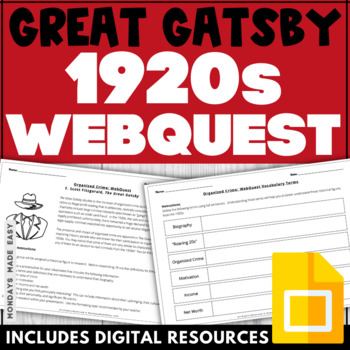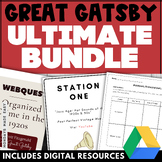The Great Gatsby Themes Research Activity - The Roaring 20s and Organized Crime
- Zip
- Google Apps™
- Webquests

Also included in
- Challenge students to move beyond online summaries and get lost in the exhilarating world of The Great Gatsby! This unit plan includes pre-reading activities, chapter-by-chapter quizzes, fun and engaging group projects, summative assessments, WebQuests, assessments, and more!⚡️⚡️ Save over 25% with thPrice $21.00Original Price $29.80Save $8.80
Description
Explore the "Roaring 1920s" and the theme of organized crime in The Great Gatsby with this collaborative research activity! Students will research the history of the 1920s and prominent historical figures, inviting them to analyze characters within The Great Gatsby and think critically about the potential allusions to real-life figures.
Included with this The Great Gatsby Themes Research Activity:
✏️ WebQuest Handout and Research Activity Instructions - Digital & Print
✏️ Vocabulary Terms Worksheet - Digital & Print
✏️ Research Presentation Template - Digital & Print
✏️ Research Graphic Organizer Worksheet - Digital & Print
✏️ Differentiated Worksheets - Digital & Print
✏️ Answer Key for Vocabulary Terms
✏️ Teacher Instructions for using this resource
How to use this The Great Gatsby Themes Research Activity:
F. Scott Fitzgerald's The Great Gatsby is a classic tale recounting the “Roaring 20s.” The novel is a fictional account of a love story between Jay Gatsby and Daisy Buchanan, told from the narrative perspective of a partially-removed character, Nick Carraway. Fitzgerald's novel captures the materialism, excess, idealism, and economic crisis of 1920s America.
This activity begins with an introductory handout that explains the relevance of organized crime to the decade of the 1920s. This handout also includes instructions to complete the research activity.
Before beginning the research activity, students can complete the accompanying vocabulary worksheet to familiarize themselves with key terms that will help them navigate the information in their research. An answer key for this activity has been included.
Students will develop a collaborative presentation using the research presentation template provided. This template is formatted for Google Slides® and is divided into five sections, one for each noteworthy criminal associated with the 1920s:
- Al Capone
- Meyer Lansky
- "Lucky" Luciano
- Arnold Rothstein
- "Bugsy" Seigel
Each criminal has been assigned a group number, along with slides that students can use to develop their presentation. You can share these slides with your entire class so that they can collaborate within the same document to create a comprehensive research presentation. You may also choose to create additional groups using the blank slides provided.
This resource also includes a graphic organizer for students to complete while they listen to their classmates' presentations. This graphic organizer includes blank spaces for any additional groups or historic figures you include in this research activity.
Differentiated worksheets and handouts have also been provided for the assignment instructions, vocabulary activity, and WebQuest template.
⭒ For classrooms utilizing Google Classroom® ⭒
To access the digital versions of these worksheets, simply follow the instructions within the resource to copy the files directly to your Google Drive®.
✨ Kindly note that due to copyright restrictions, this resource is not editable. This is a common practice within the TPT marketplace in order to protect the clip artists and software providers that have authorized their intellectual property for the development of this resource.
This resource is also included in Mondays Made Easy’s The Great Gatsby Unit Plan. This resource includes pre-reading activities, chapter-by-chapter comprehension quizzes, vocabulary worksheets, literary analysis worksheets, discussion questions, assessments, and rubrics. To preview this resource, click here.
You might also be interested in Mondays Made Easy's Literary Analysis Resources.
➖➖➖➖➖➖➖➖➖➖➖➖➖➖➖➖➖➖➖➖➖➖➖➖➖➖➖➖➖➖➖➖➖➖➖➖➖
⭐ Customer Tip! ⭐
Want FREE CREDIT to go towards purchases? Make sure to offer feedback for your downloads! Follow these instructions below:
- Go to your "My Purchases" page to find a "Provide Feedback" button next to each download.
- Follow this link to offer a quick rating and leave a short comment for the product. Each time you give feedback, TPT gives you feedback credits that you use to lower the cost of your future purchases!
- Your feedback is important to me as it helps me to continually improve my products and ensure they are meeting your needs!
➖➖➖➖➖➖➖➖➖➖➖➖➖➖➖➖➖➖➖➖➖➖➖➖➖➖➖➖➖➖➖➖➖➖➖➖➖
Follow me! Be the first to know about product launches, sales, discounts, and free giveaways:
➾ The Blog
For questions, collaborations, or other concerns:
✉ Contact me: hello@mondaysmadeeasy.com
Access my Free Resource Library!
➖➖➖➖➖➖➖➖➖➖➖➖➖➖➖➖➖➖➖➖➖➖➖➖➖➖➖➖➖➖➖➖➖➖➖➖➖
Mondays Made Easy is committed to the continual improvement of resources to meet the current needs of teachers. This product was last updated on August 19, 2021.






